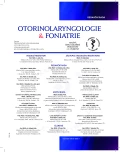Cholesteatoma Behind an Intact Tympanic Membrane – Retrospective Study
Authors:
A. Kaliariková; M. Urík; J. Macháč; L. Florianová; J. Jančíková; H. Černá
Authors‘ workplace:
Klinika dětské otorinolaryngologie, Lékařská fakulta, Masarykova univerzita, Brno)
Published in:
Otorinolaryngol Foniatr, 68, 2019, No. 1, pp. 11-17.
Category:
Original Article
Overview
Objective: The processing of the group of children operated on for a cholesteatoma behind an intact tympanic membrane. The determination of the incidence of congenital cholesteatoma in the examined group.
Methodology: This retrospective study evaluates 21 child patients from the Clinic of Pediatric Otorhinolaryngology LF MU and FN Brno (KDORL), who were operated in the period 2007 - 2017 on for cholesteatoma behind an intact tympanic membrane.
Results: During a period 2007 – 2017, a total of 202 primary operations were performed for cholesteatoma. In 21 cases (10,4%) there was a cholesteatoma behind an intact tympanic membrane and in 11 cases of it there was the congenital cholesteatoma. From the year 2013 there is an increasing trend of the detection of cholesteatoma behind an intact tympanic membrane. The most common sign of this disease was the conversion deafness and taking into account the range of cholesteatoma (stadium III according to Potsic), the atticoantrotomy was the most frequent used surgical technique for a treatment. There were 17 patients indicated for a second operation (second look), which was positive in 4 cases (23,5%).
Conclusion: The early diagnostics and the treatment of cholesteatoma behind an intact tympanic membrane in children increase the chance of complete removal of cholesteatoma, decrease the risk of recidivism as well and improve the prospects for a good hearing. The microotoscopy is the most important examination for the early detection of cholesteatoma. At an advanced stage there could be the hearing impairment and because of this reason every inexplicable unilateral hearing impairment should be always explore.
Keywords:
body mass index – cholesteatoma behind an intact tympanic membrane – congenital cholesteatoma
Sources
1. Bennett , M., Warren, F., Jackson, G. C. et al.: Congenital cholesteatoma: theories, facts, and 53 patients. Otolaryngol. Clin. North. Am., 39, 2006, 6, s. 1081-1094.
2. Černá H.: Otitis media chronica cum cholesteatomate u dětí. Brno, 2002, s. 18. Atestační práce k nástavbové atestaci z dětské ORL. Dostupné v knihovně Kliniky dětské ORL ve FN Brno.
3 Di Lella, F., Bacciu, A., Pasanisi, E.: Clinical findings and surgical results of middle ear cholesteatoma behind an intact tympanic membrane in adults. Acta. Biomed., 87, 2016, 1, s. 64-69.
4. Cho, H. S., Kim, H. G., Jung, D. J. et al.: Clinical aspects and surgical outcomes of congenital cholesteatoma in 93 children: Increasing trends of congenital cholesteatoma from 1997 through 2012. J. Audiol. Otol., 20, 2016, 3, s. 168-173.
5. Chrobok, V., Pellant, A., Profant, M. et al.: Cholesteatom spánkové kosti. Havlíčkův Brod, Tobiáš, 2008. 315 s.
6. Chrobok, V., Pellant, A., Šimáková, E. et al.: Cholesteatom za celistvým bubínkem – vrozený nebo získaný? Otorinolaryng. a Foniat., 52, 2003, 2, s. 59-65.
7. Jakubíková, J.: Vrozené anomálie hlavy a krku. Praha, Grada, 2012, 244 s.
8. Kodama, K., Hara, M., Hasegawa, M. et al.: Two cases of spontaneous regression of congenital cholesteatomas. Int. J. Pediatr. Otorhinolaryngol., 76, 2012, 1, s. 142-144.
9. Koltai, P. J., Nelson, M., Castellon, R. J. et al.: The natural history of congenital cholesteatomu. Arch. Otolaryngol. Head Neck Surg., 128, 2002, 7, s. 804-809.
10. Park, K. H., Park, S. N., Chang, K. H. et al.: Congenital middle ear cholesteatoma in children; retrospective review of 35 cases. J. Korean Med. Sci., 24, 2009, 1, s.126-131.
11. Potsic, W. P., Samadi, D. S., Marsh, R. R. et al.: A staging system for congenital cholesteatoma. Arch. Otolaryngol. Head Neck Surg., 128, 2002, 9, s. 1009-1012.
12. Rohlfing, M. L., Sukys, J. M., Poe, D. et al.: Bilateral congenital cholesteatoma: a case report and review of the literature. Int. J. Pediatr. Otorhinolaryngol., 107, 2018, 4, s. 25-30.
13. Rutkowska, J., Özgirgin, N., Olszewska, E.: Cholesteatoma definition and classification: a literature review. J. Int. Adv. Otol., 13, 2017, 2, s. 266-271.
14. Smouha, E. E., Bojrab, D. I.: Cholesteatoma. [online] New York, Thieme, 2012 [cited 2018 Aug 21]. Dostupné z URL: http://search.ebscohost.com.
15. Stapleton, A. L., Egloff, A. M., Yellon, R. F.: Congenital cholesteatoma: predictors for residual disease and hearing outcomes. Arch. Otolaryngol. Head Neck Surg., 138, 2012, 3, s. 280-285.
16. Takahashi, H.: Cholesteatoma and ear surgery: An Update. [online] The Hague, Kugler Publications, 2013 [cited 2018 Aug 21]. Dostupné z URL: http://search.ebscohost.com.
17. Tos, M.: A new pathogenesis of mesotympanic (congenital) cholesteatoma. Laryngoscope, 110, 2000, 11, s. 1890-1897.
18. Urík, M.: Histologické a histochemická analýza retrakční kapsy pars tensa ušního bubínku u dětí. Brno, 2017, s. 87. Dizertační práce. Masarykova univerzita. Lékařská fakulta. Klinika dětské ORL. Dostupné z URL: https://is.muni.cz/th/kn4rx/Dizertace.pdf.
Labels
Audiology Paediatric ENT ENT (Otorhinolaryngology)Article was published in
Otorhinolaryngology and Phoniatrics

2019 Issue 1
Most read in this issue
- Congenital Stridor
- Asymmetric Hearing Loss
- Cholesteatoma Behind an Intact Tympanic Membrane – Retrospective Study
- Tumor Microenvironment
